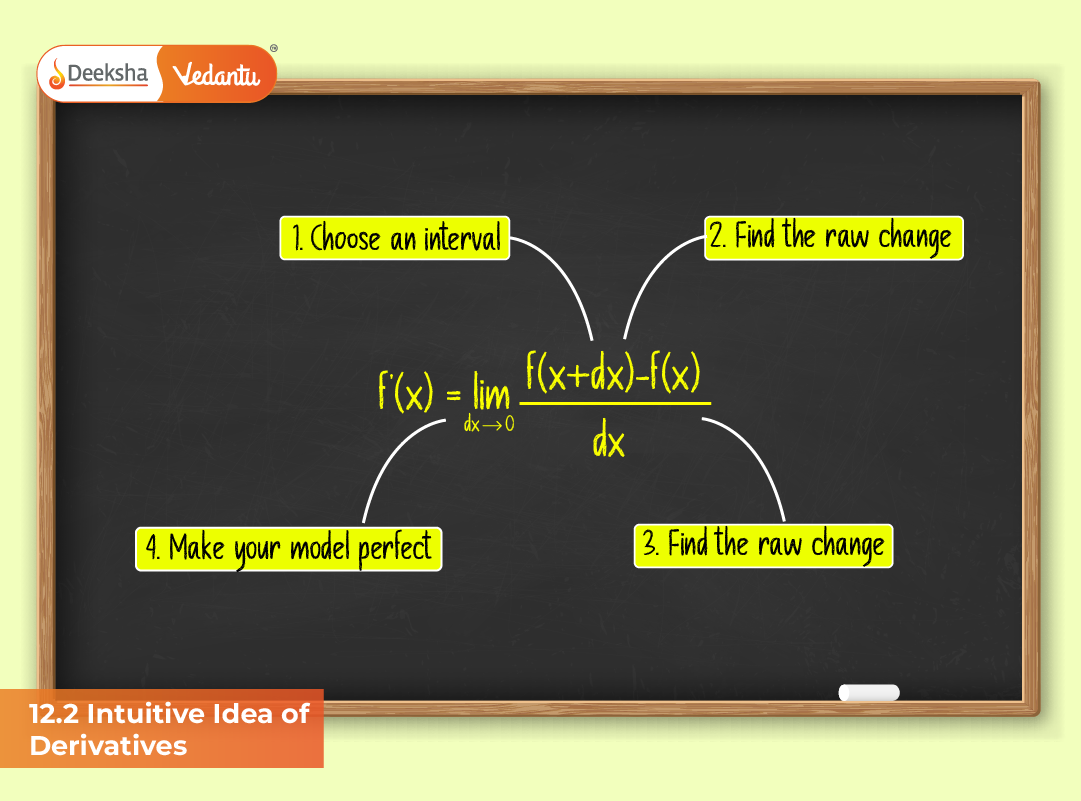
The concept of derivatives lies at the heart of calculus and is one of the most important topics for JEE aspirants. This section introduces the intuitive idea of derivatives – understanding what a derivative means, how it connects to rate of change, and why it’s fundamental in solving real-world and JEE-level mathematical problems.
Marks Weightage in JEE
| Exam Type | Approx. Marks Weightage | Average No. of Questions |
| JEE Main | 8–12 marks | 2–3 questions |
| JEE Advanced | 10–14 marks | 2–3 questions |
The concept of derivatives forms the basis for many advanced calculus questions, making it a high-weightage topic in both JEE Main and JEE Advanced.
Introduction to Derivatives
In simple terms, a derivative measures how a quantity changes when another quantity changes. In other words, it represents the rate of change of one variable with respect to another. If you’ve ever calculated speed (change in distance over time), you’ve already used a basic idea of derivatives.
For example:
- The rate of change of distance with respect to time gives velocity.
- The rate of change of velocity with respect to time gives acceleration.
In mathematics, we express this concept as:
f'(x) = lim (h→0) [(f(x + h) – f(x)) / h]
This formula represents the derivative of the function f(x) at point x.
Real-World Intuition Behind Derivatives
Imagine a car traveling on a highway. If you know how far the car has traveled after each second, you can find how fast it was going at any instant. That “instantaneous rate of change” is exactly what a derivative tells us.
- If the graph of distance vs. time is a curve, the derivative gives the slope of the tangent to that curve at a specific point.
- A steeper slope means a higher speed.
- A flat (horizontal) slope means the speed is zero.
So, intuitively, the derivative gives the rate at which one variable (like distance) changes with respect to another (like time).
Visual Understanding
Consider a curve representing y = f(x). If you pick two points, say A(x, f(x)) and B(x + h, f(x + h)), and draw a secant line between them, the slope of this line is:
(f(x + h) – f(x)) / h
As you move point B closer to point A, h approaches zero, and the secant line becomes the tangent line. The slope of this tangent line represents the derivative at that point.
This process – taking the limit as h approaches zero – gives the exact rate of change at a specific point.
Mathematical Definition
Let y = f(x). Then the derivative of f(x) with respect to x is defined as:
f'(x) = lim (h→0) [f(x + h) – f(x)] / h
If this limit exists, f(x) is said to be differentiable at x.
This expression captures how small changes in x affect changes in y. If f'(x) is large, a small change in x produces a large change in y, meaning the curve rises or falls steeply.
Example to Understand Intuitive Idea of Derivatives
Example 1: Find the derivative of f(x) = x² at x = 3.
Solution:
f'(x) = lim (h→0) [(x + h)² – x²] / h
= lim (h→0) [(x² + 2xh + h² – x²)] / h
= lim (h→0) [2x + h]
= 2x
Therefore, f'(3) = 2(3) = 6.
So, the slope of the tangent to the curve y = x² at x = 3 is 6.
Graphical Insight
If we plot y = x², the curve becomes steeper as x increases. The tangent slope (or derivative) also increases with x. This means as x increases, the rate of change of y increases. The curve rises faster as you move to the right.
This is the intuitive picture of a derivative – it tells how fast something changes and in what direction.
Relation Between Derivative and Slope
In coordinate geometry, slope = rise/run = (change in y)/(change in x).
The derivative represents the instantaneous slope of a curve – that is, how steep the curve is at a specific point.
If f'(x) > 0, the function is increasing at that point.
If f'(x) < 0, the function is decreasing.
If f'(x) = 0, the function has a stationary point (possibly a maximum, minimum, or inflection point).
JEE-Focused Problem Types
JEE questions on intuitive idea of derivatives usually test conceptual understanding rather than complex calculation. Common problem types include:
- Finding instantaneous rate of change
- Graphical interpretation of derivatives
- Understanding slope and tangent relationship
- Application-based questions involving motion, growth, or decay
Solved JEE-Based Examples
Example 1: If f(x) = 3x² + 2x + 1, find f'(x).
Solution:
Using the formula: f'(x) = lim (h→0) [f(x + h) – f(x)] / h
f'(x) = lim (h→0) [(3(x + h)² + 2(x + h) + 1) – (3x² + 2x + 1)] / h
= lim (h→0) [(3x² + 6xh + 3h² + 2x + 2h + 1 – 3x² – 2x – 1)] / h
= lim (h→0) [(6xh + 3h² + 2h) / h]
= lim (h→0) [6x + 3h + 2]
= 6x + 2
Example 2: The slope of the tangent to the curve y = x³ at x = 2.
f'(x) = 3x²
f'(2) = 3 × 2² = 3 × 4 = 12
So, the slope of the tangent at x = 2 is 12.
Example 3: If s = t² + 3t + 2, find the rate of change of s with respect to t at t = 4.
s'(t) = 2t + 3
s'(4) = 2(4) + 3 = 8 + 3 = 11
Hence, at t = 4, the rate of change of s with respect to t is 11.
Conceptual Questions for JEE Practice
- If f(x) = sin(x), what is the meaning of f'(x)?
- Why is the derivative at a point equal to the slope of the tangent?
- What happens if the limit in the derivative formula doesn’t exist?
- How is the derivative related to increasing or decreasing functions?
Such questions build conceptual clarity – essential for JEE Advanced.
Common Mistakes Students Make
- Forgetting to apply the limit correctly.
- Confusing derivative with average rate of change.
- Misinterpreting negative derivatives as “decreasing slope” instead of “negative rate of change.”
- Ignoring units while applying derivatives in motion problems.
Tips to Master the Concept
- Visualize graphs – always relate derivatives to slopes.
- Solve basic problems before jumping to complex functions.
- Derive formulas manually a few times to understand their origin.
- Regularly practice JEE Main and Advanced PYQs from this chapter.
Applications of the Intuitive Idea of Derivatives
- Physics: Understanding motion – velocity and acceleration.
- Economics: Rate of change in cost, profit, and demand functions.
- Biology: Growth rate of populations.
- Engineering: Optimization and control systems.
This wide applicability makes derivatives one of the most valuable tools in mathematics and science.
Summary of Key Formulas
- Derivative definition: f'(x) = lim (h→0) [(f(x + h) – f(x)) / h]
- Slope of tangent = Derivative at that point
- If derivative > 0 → Function increasing
- If derivative < 0 → Function decreasing
- If derivative = 0 → Stationary point
FAQs
Q1. What is the intuitive meaning of a derivative?
The derivative represents how one quantity changes in response to another. For instance, it shows how fast distance changes with time, which is velocity.
Q2. How is the derivative connected to slope?
The derivative gives the slope of the tangent to the curve at a specific point – showing the rate of change at that point.
Q3. Is the derivative always positive?
No. The derivative can be positive, negative, or zero depending on whether the function is increasing, decreasing, or stationary at that point.
Q4. What are some real-world examples of derivatives?
Examples include speed (rate of change of distance), growth rate in biology, and rate of change in economics.
Q5. How can I prepare this topic for JEE?
Start by understanding the geometric interpretation, then move to formula-based derivations and numerical examples from previous JEE papers.
Conclusion
The intuitive idea of derivatives provides the foundation for understanding change – whether in physics, mathematics, or real life. It connects algebra and geometry beautifully by explaining how curves behave and how their slopes change. For JEE aspirants, mastering this intuition is the key to solving complex calculus problems with confidence.






Get Social